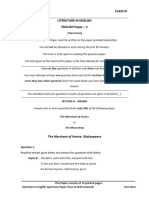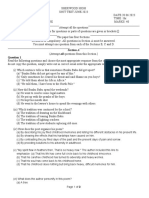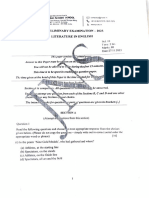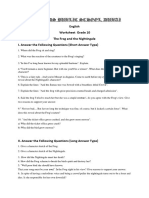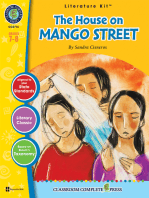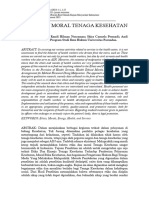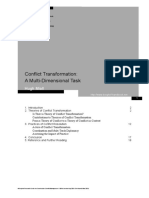Night Mail
Night Mail
Uploaded by
Gamini JayasingheOriginal Description:
Copyright
Available Formats
Share this document
Did you find this document useful?
Is this content inappropriate?
Report this DocumentCopyright:
Available Formats
Night Mail
Night Mail
Uploaded by
Gamini JayasingheCopyright:
Available Formats
Night Mail
This is a simple poem highlighting the various
characteristics of a night mail. It brings various
types of postal material for each kind of people. It
also passes through various fields, meadows, and
ups and downs to reach its destiny. Night mail
actually resembles life that passes through
different courses to reach its destiny. "The Night
Mail" brings different kinds of postal material. It
passes through different ups and downs.
Nobody can alter its course. It reaches its destiny
in time. When it passes, nothing moves but only a
jug lying on a table moves slightly.The Night Mail is
the train that travels at night and carries mail. It is
night.
The Night Mail is running towards its destination. It
is bringing mail containing cheques, postal orders,
ordinary letters, business letters, and love letters
etc. It serves the rich and the poor at the same
time. it helps to promote business and relations. It
establishes communication between people living
in different parts of the country.
Whatever the weather 't is, it does its job. People
are waiting for their mail. The shopkeeper is
anxious about his cheque or Postal order. The next
door girl is waiting for her love letter. It has to
reach its destination on time. Nobody can alter its
course. It reaches its destiny in time. When it
passes, nothing moves but only a jug lying on a
table moves slightly.
The Night Mail stops at certain stations. Then, after
a short while, it moves again and travels on a
steady climb. It travels on upward and downward
slopes, but it does not get late. It reaches its
destinations on time. It passes by grassy fields and
uncultivated treeless stretch of land. It passes by a
large round rock. The poet teaches us that a man,
like a train, sees different periods of life. He has to
face hard days.
He also enjoys pleasures of life. Whatever the
circumstances are, like a train, he should be
regular, punctual and sturdy. He should do his duty
earnestly. It will bring him success arid fame. The
birds look at her plain coaches from the bushes. It
continues its journey. It has to travel on a fixed
path. It has no time to stand and stare. The
sheepdogs Know that they cannot force the train to
change its direction by barking at it or by running
after it. So they sleeping calmly with their paws
crossed.
The Night Mail carries mail for people of different
villages, towns and cities. So it is welcome
everywhere. We can say that it does not create any
problem for the people. Instead of it, it helps the
people.the night mail brings letters also for the
next-door girl who is perhaps, waiting for the
letters of her lover anxiously.
When the birds sitting in the bushes hear the
sound of the train they become attentive. They
move their heads towards it and start looking at its
coaches.
A train is a nonliving thing. The poet regards it as
a living thing. This is called personification and the
nonliving thing described as a living thing is called
personified. In this poem, the Night Mail is
personified by using words like, snorting noisily,
etc. In this way the poet change a lifeless thing into
a living one. The Night Mail passes through many
high and low areas. It passes by moorland boulder
and the fields of cotton.
Lahore Attack
Hello! You asked about Kumar Sangakkara's speech on the 2009 Lahore
attack against the Sri Lankan national cricket team.
Sangakarra starts his speech by telling his audience about the history of Sri
Lanka and her people. He is proud of his country's heritage: close-knit
families, strong communities, and a fiercely hospitable culture. He describes
how the game first provides an opportunity for affluent Sri Lankans of all
races, castes and religious beliefs to come together to indulge a shared
passion. When the game is opened to the masses, it solidifies the place of this
very English game in Sri Lankan hearts. Sangakarra is fiercely protective of
the unifying elements of this game. He admits that Sri Lankan cricket players
first had to overcome a prevalent national sense of ennui and dysfunction
before they could succeed as a national team. However, he draws on the
history of his childhood experience to assure us that the struggle to
incorporate a strong Sri Lankan identity into the sport has been well worth the
effort.
Sangakarra remembers how his brave parents hid Tamil friends in their family
home (during the civil wars) and how as a little boy, he was incredulous with
joy when he found so many friends to play with every day. His speech
highlights this child-like sense of acceptance and camaraderie among
Sangakarra and his playmates. Not one of the children cared whether they
were Tamil or Buddhist or any other religion: they were all playmates. Such is
also the unifying and harmonizing influence of cricket. Sangakarra contends
that it was the 1996 World Cup (Sri Lanka won the final, beating Australia)
which showed the world that Sri Lankans were able to take a wholly English
sport and infuse a strong Sri Lankan identity into its national play.
We were no longer timid, or soft, or minnows. We had played and beaten the
best in the world.We had done that without pretence or shame in a manner
that highlighted and celebrated our national values, our collective cultures and
habits. It was a brand of cricket we were proud to call our own, a style with
local spirit and flair embodying all that was good in our heritage.
Here were 15 individuals from different backgrounds, races, and religions,
each fiercely proud of his own individuality and yet they united not just a team
but a family.
Sangakarra is fiercely unapologetic about his belief that cricket has provided
an avenue for Sri Lankans to transcend the brutality of war, torture and
persecution. He is adamant that his people can become a peaceful and a
proud nation, healing itself from within, and taking its long awaited place on
the world stage with confidence and courage.
The sport overwhelmed terrorism and political strife; it provided something
that everyone held dear to their hearts and helped normal people get through
their lives.
Sangakarra cites the importance of free expression and innovative thinking
when it comes to coaching prospective Sri Lankan players. He proudly
defends this unorthodox approach as the basis for true success in the game.
He is confident that cricket will be even more important to modern day Sri
Lanka and that its unifying factor should mirror a new political reality: the true
spirit of cricket is tolerance and shared values. Qualities of Sangakarra: he is
courageous, forward-thinking, unorthodox and patriotic.
Caged Bird
The quotation above is a significant stanza of the poem, CAGED BIRD.
The stanza explicitly displays the true meaning of the poem and defines
actions of a "caged bird." Blackness of skin acts as a barrier for the
black race; it prevents freedom for a person. The freedom, and feelings of
a white person's existence are unknown to one who is black. Here, Maya's
belief for freedom and equality is beginning to spread among the black
race. She "sings" for freedom.
Throughout history, barriers have been put up between races.
Divisions and inequities between blacks and whites have existed since
ancient times. It's an enigma regarding how heritage has incurred blacks
with slavery, and why discrimination and racism exist. Nevertheless, the
Civil Rights Movement, actions of Martin Luther King Jr., Rosa Parks, and
the trials of Brown vs. The Board of Education of Topeka, and Plessy vs.
Ferguson (Separate but Equal, 1896) are examples of how blacks have
slowly "sang" for equality. For more than three hundred years, a wrongful
tradition of slavery and discrimination has existed. This ongoing black
inferiority and white supremacy (ethnocentrism) is bound in tradition and
hard to sever. Blacks are slowly overcoming the dominance of whites to
blacks.
Through tradition and history, whites have been given hopes and
spirit; blacks are servile and bound by tradition. This controversy is
condoned and accepted. Tradition has caused the death of black dreams and
hope. If a black person existed retaining the same amount of knowledge,
skill, and talent of a white person, who would succeed more in life? The
poem infers that the probable answer would be a white person, because
blacks are "caged" by their color. Opportunities infinitely exist for
whites, whereas the same is false for blacks.
In her book, I Know Why the Caged Bird Sings, and her poem, Caged
Bird, a similar message (blacks are slowly overcoming tradition) is
shared. In Maya's autobiography, she gets a job as a streetcar
conductor. The significance is that Maya disturbed what was customary
(only whites had streetcar jobs). She defied the tradition set from
history, and pervaded pure hopes and dreams for black equality.
The metaphors from Caged Bird are well used and creative. Perhaps
the interpretation of the poem could have been communicated using bees,
flowers, roots, and pollen as metaphors.
bees~
wings for flight~
flowers~
roots~
pollen~
white race
white tradition carried through history,
black race
black tradition of unequal opportunities, permanent
in the ground
opportunities, that can be carried by the bees,
but can remain in the flowers
You might also like
- Haunted HousesDocument38 pagesHaunted Housesvenuspoliston123100% (1)
- The Elevator: PART A: Comprehension QuestionsDocument6 pagesThe Elevator: PART A: Comprehension QuestionsWaris Ahmad100% (1)
- Project Management MCQDocument3 pagesProject Management MCQGroup 34100% (2)
- Citipointe Live - Hope Is Erupting Music Book PDFDocument27 pagesCitipointe Live - Hope Is Erupting Music Book PDFJay ScribdNoch keine Bewertungen
- Grade - X English Grammar NOTESDocument27 pagesGrade - X English Grammar NOTESTanush100% (1)
- Louse and The MosquitoDocument3 pagesLouse and The MosquitoSamarth SharmaNoch keine Bewertungen
- The Boy Who Broke The Bank: Learning OutcomesDocument12 pagesThe Boy Who Broke The Bank: Learning OutcomesDelta StreamNoch keine Bewertungen
- The Night MailDocument3 pagesThe Night MailDamian Fernandes50% (2)
- ISC English PaperDocument5 pagesISC English PaperFerbInventorNoch keine Bewertungen
- Choithram School North Campus Class X Subject: English Notes DATE: 29/10/2018Document15 pagesChoithram School North Campus Class X Subject: English Notes DATE: 29/10/2018Nimisha DhakadNoch keine Bewertungen
- Barron's Book Notes - Shakespeare, William - Julius CaesarDocument66 pagesBarron's Book Notes - Shakespeare, William - Julius Caesarkriskee13Noch keine Bewertungen
- The Night Mail (Class IX)Document9 pagesThe Night Mail (Class IX)arnavkunal174Noch keine Bewertungen
- Fire and Ice X Questions AnswersDocument6 pagesFire and Ice X Questions AnswersAarmita ohriNoch keine Bewertungen
- A DoctorDocument4 pagesA DoctormdsohaibjameelNoch keine Bewertungen
- Grade 8 NotesDocument9 pagesGrade 8 NotesGeetha.H.R 9th G.H.S.HonsigereNoch keine Bewertungen
- Nine Gold Medals Qa Eng LitDocument9 pagesNine Gold Medals Qa Eng LitFreya SanghviNoch keine Bewertungen
- I Remember I Remember Class 9 Icse Workbook AnswersDocument8 pagesI Remember I Remember Class 9 Icse Workbook Answersavantikaa.baidNoch keine Bewertungen
- Reading Comprehension Activity Tyger TygerDocument8 pagesReading Comprehension Activity Tyger TygerRenuga I. KuppusamyNoch keine Bewertungen
- The Little Match GirlDocument6 pagesThe Little Match GirlAnuradha MayanikarNoch keine Bewertungen
- Dust of Snow SummaryDocument5 pagesDust of Snow SummarySwapnilNoch keine Bewertungen
- An Analysis of A Work of Artifice by Merge PiercyDocument1 pageAn Analysis of A Work of Artifice by Merge PiercyindahNoch keine Bewertungen
- Outline CL101 A Work of ArtificeDocument2 pagesOutline CL101 A Work of ArtificePaul Roevel QuiraoNoch keine Bewertungen
- Article Writing: Grade ViiiDocument10 pagesArticle Writing: Grade ViiiVinal99Noch keine Bewertungen
- The Night Mail - Watermark-1Document6 pagesThe Night Mail - Watermark-1srinjon8210Noch keine Bewertungen
- ICSE Class 9 English Literature Sample Paper Official PDFDocument14 pagesICSE Class 9 English Literature Sample Paper Official PDFDebashree MukherjeeNoch keine Bewertungen
- Study Guide For Julius CaesarDocument11 pagesStudy Guide For Julius CaesarNoah Kasper100% (1)
- Notes L3 - Little GirlDocument3 pagesNotes L3 - Little GirlRudra PatelNoch keine Bewertungen
- ICSE Class 10 English 2012Document15 pagesICSE Class 10 English 2012SACHIDANANDA SNoch keine Bewertungen
- Grade 8 English Language Arts - Reading ComprehensionDocument10 pagesGrade 8 English Language Arts - Reading Comprehensiondandouna.mohamedNoch keine Bewertungen
- Act I Quiz With AnswersDocument3 pagesAct I Quiz With Answersropano1100% (1)
- Night Mail Class 9 Icse Workbook AsnwersDocument9 pagesNight Mail Class 9 Icse Workbook Asnwersavantikaa.baidNoch keine Bewertungen
- English Literature - Test Paper 1Document9 pagesEnglish Literature - Test Paper 1qNoch keine Bewertungen
- Anne Frank 2marks and 3 MarksDocument9 pagesAnne Frank 2marks and 3 Marksjeya moorthyNoch keine Bewertungen
- 8 - English-Refugee Blues-NotesDocument6 pages8 - English-Refugee Blues-NotesMuhammad Shahid Ashraf100% (2)
- Treasure Trove Workbook Answers After BlenhiemDocument46 pagesTreasure Trove Workbook Answers After BlenhiemHarini100% (3)
- ICSE Guess - ICSE Papers - Question Bank - Class X - 2008 - English PDFDocument2 pagesICSE Guess - ICSE Papers - Question Bank - Class X - 2008 - English PDFRajendra50% (2)
- Grade 9.UT1.Eng Lit June'23Document3 pagesGrade 9.UT1.Eng Lit June'23Rohan CharlesNoch keine Bewertungen
- Icse English Language Transformation of SentencseDocument3 pagesIcse English Language Transformation of SentencseShivakumar.R licNoch keine Bewertungen
- Work of Artifice Question AnswersDocument6 pagesWork of Artifice Question Answersavantikaa.baidNoch keine Bewertungen
- WS EngDocument2 pagesWS EngsaraswathiNoch keine Bewertungen
- ISC English Language Specimen Paper 2023 (PDF) - CISCE Class 12 English Paper-1 Sample PaperDocument1 pageISC English Language Specimen Paper 2023 (PDF) - CISCE Class 12 English Paper-1 Sample PaperpriyanshiNoch keine Bewertungen
- Act 1 Scene 1-1Document2 pagesAct 1 Scene 1-1Rakhit MahatoNoch keine Bewertungen
- The Hero Making Connections: Summary of The PoemDocument3 pagesThe Hero Making Connections: Summary of The PoemDev Sisodiya100% (3)
- Treasure Trove Workbook Answers The Blue BeadDocument11 pagesTreasure Trove Workbook Answers The Blue BeadRohan CharlesNoch keine Bewertungen
- Eng Lit Prelim 1Document7 pagesEng Lit Prelim 1vijaya lakshmi100% (1)
- In The Kingdom of FoolsDocument2 pagesIn The Kingdom of FoolsVinayak ParasharNoch keine Bewertungen
- The Ball PoemDocument4 pagesThe Ball PoemPreetanshi RanaNoch keine Bewertungen
- The Adventures of TotoDocument3 pagesThe Adventures of TotoIX17-41 Suvayu ChatterjeeNoch keine Bewertungen
- TSD - IX - Eng - The Lake Isle of InnisfreeDocument8 pagesTSD - IX - Eng - The Lake Isle of Innisfreeshriya's worldNoch keine Bewertungen
- Class 10 English Analytical ParagraphDocument26 pagesClass 10 English Analytical ParagraphsrikanthNoch keine Bewertungen
- Indigo by Louis FischerDocument6 pagesIndigo by Louis Fischermitasha_saini100% (5)
- An Angel in DisguiseDocument5 pagesAn Angel in DisguiseWellington LinsNoch keine Bewertungen
- The Solitary Reaper XZDocument4 pagesThe Solitary Reaper XZTaibur RahamanNoch keine Bewertungen
- Julius Caesar Teacher Sample 6x9 InsetDocument10 pagesJulius Caesar Teacher Sample 6x9 InsetVidhi Agarwal0% (1)
- English Literature-NotesDocument15 pagesEnglish Literature-Notesvickram shettyNoch keine Bewertungen
- A Hero by R.K.Narayan: HouseDocument1 pageA Hero by R.K.Narayan: HouseKathy WongNoch keine Bewertungen
- A Doctor's Journal EntryDocument19 pagesA Doctor's Journal EntrySwara BatheNoch keine Bewertungen
- In The Bazaars of HyderabadDocument18 pagesIn The Bazaars of Hyderabad1abdullahkhan2011Noch keine Bewertungen
- CHAPTER-2 The Thief's StoryDocument4 pagesCHAPTER-2 The Thief's StoryManthan KheraNoch keine Bewertungen
- Worksheet - Frog and The NightingaleDocument2 pagesWorksheet - Frog and The Nightingaleanon_50109362100% (1)
- Overcoming Fear - Hbi HandoutDocument1 pageOvercoming Fear - Hbi HandoutSharon PeterNoch keine Bewertungen
- Narrative Report: Week 2 - NSTP OrientationDocument6 pagesNarrative Report: Week 2 - NSTP OrientationKarma Gomez De LianoNoch keine Bewertungen
- 02 Activity 2Document2 pages02 Activity 2evelinda gipitNoch keine Bewertungen
- List of Legislation For Health and SafetyDocument5 pagesList of Legislation For Health and SafetyhogoshNoch keine Bewertungen
- The Salesman Analysis by Tanmay TandonDocument2 pagesThe Salesman Analysis by Tanmay TandonTanmay TandonNoch keine Bewertungen
- RULE 131 Sec 3 Rules of CourtDocument10 pagesRULE 131 Sec 3 Rules of CourtJose Maria Jude DuremdesNoch keine Bewertungen
- Praxis Vol1No12022 Kevin 1Document13 pagesPraxis Vol1No12022 Kevin 1pranata panjaitanNoch keine Bewertungen
- Accomplice EvidenceDocument15 pagesAccomplice EvidenceGurpreet Singh Mandair50% (2)
- F10neuman Affective LearningDocument12 pagesF10neuman Affective LearningZiar Lazuardi FitriyanaNoch keine Bewertungen
- Contract Law (Law College)Document225 pagesContract Law (Law College)Audi RamanaNoch keine Bewertungen
- People Vs Marcos - 070 Phil 468Document10 pagesPeople Vs Marcos - 070 Phil 468Jobi BryantNoch keine Bewertungen
- Module 34 EgDocument102 pagesModule 34 Egkonica chhotwaniNoch keine Bewertungen
- ART322: Great Directors, Fall 2014 SyllabusDocument6 pagesART322: Great Directors, Fall 2014 SyllabusdrewayersNoch keine Bewertungen
- Interplay Chapter 11Document10 pagesInterplay Chapter 11aleejkNoch keine Bewertungen
- Conflict Transformation: A Multi-Dimensional Task: Hugh MiallDocument20 pagesConflict Transformation: A Multi-Dimensional Task: Hugh MiallellaNoch keine Bewertungen
- What Are The Two Types of Imagination According To ColeridgeDocument4 pagesWhat Are The Two Types of Imagination According To ColeridgeKumaresan RamalingamNoch keine Bewertungen
- Child Labor Performance TaskDocument3 pagesChild Labor Performance Taskapi-243037850Noch keine Bewertungen
- Private Practice of ProfessionDocument1 pagePrivate Practice of ProfessionAngel JinHiroNoch keine Bewertungen
- Joyful Living: (Based On Chapter 11: Yogananda Prakaranam of Panchadashi of Sri Vidyaranya Swami)Document19 pagesJoyful Living: (Based On Chapter 11: Yogananda Prakaranam of Panchadashi of Sri Vidyaranya Swami)Raja SubramaniyanNoch keine Bewertungen
- To Whom It May Concern Letter To Parliamentary Inquiry by Elliot SgargettaDocument4 pagesTo Whom It May Concern Letter To Parliamentary Inquiry by Elliot SgargettaSenateBriberyInquiryNoch keine Bewertungen
- Culture and Sales: Sales Management: A Global PerspectiveDocument21 pagesCulture and Sales: Sales Management: A Global Perspectivesimply_cooolNoch keine Bewertungen
- Theories of Gender Communication: Genderlect Theory - Deborah TannenDocument2 pagesTheories of Gender Communication: Genderlect Theory - Deborah TannenYenyen Quirog-PalmesNoch keine Bewertungen
- Ebook Educational Research Quantitative Qualitative and Mixed Approaches 6Th Edition Johnson Solutions Manual Full Chapter PDFDocument27 pagesEbook Educational Research Quantitative Qualitative and Mixed Approaches 6Th Edition Johnson Solutions Manual Full Chapter PDFgloriaazurah8ki100% (12)
- Inequality and HierarchyDocument12 pagesInequality and HierarchyAvinashKumar50% (2)
- Cognitive DissonananceDocument16 pagesCognitive DissonanancemayankNoch keine Bewertungen
- An African Epistemological Approach To Certitude and ScepticismDocument21 pagesAn African Epistemological Approach To Certitude and ScepticismAnselm JimohNoch keine Bewertungen
- LEARNINGS .: 1 1St Module - Law of ContractDocument19 pagesLEARNINGS .: 1 1St Module - Law of ContractAsha RaiNoch keine Bewertungen
- Untitled PresentationDocument33 pagesUntitled PresentationCarla De La CruzNoch keine Bewertungen

























